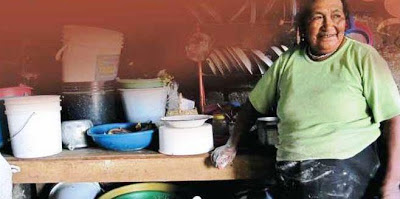![]()
By:Jose Fabara-Rojas cucuyo@rocketmail.com
Have you seen how people travel on the bus? Asleep! At any time, in the morning, in the afternoon. And it's because they don't eat well" - that's how my grandmother Martha began the conversation, one afternoon when I was “Nobody takes the time to prepare food properly anymore, now they only like those meals ready to heat up in the microwave, or those cheap hamburgers and pizzas,” he continued tirelessly. “They are no longer interested in cooking, they have neither the time nor the desire, the kids don’t know how to make a good soup, and even less a good stir-fry,” he concluded.
From that conversation came the idea of sitting next to my grandmothers, and listening patiently and lovingly to everything they could tell me about food, from its preparation and culinary secrets, to the oral culture that surrounds the mysterious space that is the kitchen.
I thought, grandmothers know so much about the subject, and we can't lose that knowledge. And so for a few weeks, together with Karla Muñoz, we visited several women, our grandmothers, grandmothers of friends. Sometimes we just talked (actually we mostly listened), and with each one of them the experience was fascinating, it was like traveling to the past, through time, imagining. Each one felt like a queen, a very important person, and no wonder, since their knowledge and memories are spectacular. Grandmothers know the reason for things. Mothers teach you that a broth should be made in a certain way, but grandmothers tell you why it should be made that way, what it implies and what results you will get. And that is a big difference.
Sometimes they let us into their private world, into their kitchen. There, among anecdotes, jokes, and secrets, we could observe every detail of their individual way of including the ingredients, since for them there are no measurements, there is only their memory and the recollection of what they have been doing all their lives. The work is complex, not at all simple, and requires a lot of time, which is why Grandma Martha said that she does not understand how they dare to say that housework, in the kitchen, is easy. “If the health of the whole family is also in our hands!” They are aware of the responsibility they have in their hands.
The hours spent with the grandmothers have become moments and experiences that are difficult to describe. It was very nice to achieve an intimate relationship for a few minutes, and in that way to travel and share together what we have always wanted.
How wonderful is the relationship between humans and their food. Making a collection of recipes was just a pretext, an excuse to transport us to the magical world of cooking, and to rescue its essence.
The fruit of our work, that inexact sum of ingredients and portions, we want to make available to those people who do not want to live in a world where that inheritance that belongs to us by right and identity, but that we are losing through sheer carelessness, no longer exists. With this we also seek to inspire them and give themselves time to let themselves be carried away by food and surrender to the act of CREATING for themselves.
FEED.
Below are two recipes that come from those moments:
- Barley horchata
Horchata is a drink inherited from cereal cultures, and is highly appreciated in the Ecuadorian South. Nowadays, a packaged, ready-to-drink version can be found in stores, but it is only a herbal tea. The essence of horchata is the cooking of cereals, and the sifting that leaves intact some of the nutritional properties of the grass. It is a drink that only grandmothers remember well how to make.
prepare. This could be due to the time it takes to prepare.
Ingredients
- 1/2 pound barley rice
- 3 liters of water
- Brown sugar/panela to taste
- Cinnamon to taste
- Lemon to taste
Preparation
Grandma Martha lets the barley rice boil all morning. She brings a 3-quart pot of water to a boil with 1/2 pound of barley rice. Before it boils, she removes the bran that begins to rise to the surface,
“fishing” it with a sieve. Once the barley rice is clean, let it cook slowly over low heat.
The secret of horchata is precisely that the cereal that is cooked has enough cooking time to release the starch. When she doesn't have much time to cook it, the grandmother leaves the barley to soak
the night or at least the morning before preparation.
After boiling for a long time, when the mixture is thick enough, add a few cinnamon sticks and boil for five more minutes.
Grandma Martha says that she used to add the cinnamon well in advance until one day she read that it is not good for cinnamon to boil too much. Although she does not remember the exact reason for doing this, she prefers to do it this way so that the flavor of the cinnamon does not predominate in the brew.
Once the cinnamon is boiled, she sifts everything and squeezes a couple of lemons or mandarins. She adds brown sugar or panela and tests it by placing a few drops in her hand. She says that it can be taken cold or warm, which is how it is.
Grandpa likes it the most. Sometimes he uses passion fruit instead of lemon. This gives it a delicious touch.
She also says that horchata is wonderful for the stomach. She was given it when she had a lot of diarrhea, because it rebuilds the intestinal flora. She remembers that she drank it when she had intestinal infections and that
They said it was good for the rickets.
- Ham of turnips
Ingredients
- Salt water. Salt hardens, so it is added when the potato is already soft and cooked.
- Toasted sambo seed. To toast it, place it in a pot or pan over low heat, stirring constantly so that it does not burn. When it begins to pop, remove from heat and allow to cool.
- Turnips. Quite a few turnips go into this recipe. Turnips are high in calcium and vitamin K, concentrated mainly in the stem. To keep them fresh after purchase, they can be placed in water. If they are not used that same day, they can be stored in a plastic bag in the refrigerator.
- Small potatoes. The ones used in jaucha were the ones that people didn't want, so it was easy to get them, even on the street. That's why it is said that this was a poor man's food.
- White onion.
- Annatto butter. Grandma prepares her achiote by mixing it with hot lard, then straining it through a metal sieve. Once the mixture is smooth, it is placed in a container and stored for use in meals.
- Milk. About a cup.
Preparation
The potatoes are cooked with their skins on and without salt. When they begin to soften, they are removed from the heat and peeled. They should not be overcooked because otherwise they cannot be peeled easily and will fall apart. They will then be finished cooking with the stir-fry and the turnips. Once peeled, they are left to rest while the rest is prepared.
The soaked turnips are washed, leaf by leaf. The stems are removed and the leaves are cut into small rows. A pot of water with salt and onion is placed on the fire. After it boils, it is left to cook for a while.
more; remove the onion and add the chopped turnips. To know when they are ready, grandma tests a stem, if it is cooked, remove the pot from the heat.
Chop the same amount of onion. In a frying pan, heat enough water to cover the onion that has been chopped with a little salt.
Making the refrito with water allows the onion to cook well, without burning like with oil, says the grandmother. To this, add a spoonful of lard and enough achiote butter to give it color (to taste). The lard should not boil, so it is added near the end. The refrito will be ready when the onion is transparent.
Separately, blend a cup of milk with a little salt. Crush the toasted sambo seeds in your hands to remove the green skin and add them to the blend. If necessary, add milk until you reach the desired thickness, which should remain rather liquid.
Once everything is ready, add a splash of milk to the stir-fry and add the turnips. Also add the potatoes and mix well.
Finally, add the pepa sauce and a little water to wash what is left in the blender. If it lacks color, add achiote and stir well so that all the flavors mix. Let it cook a little longer and serve.

.jpg)